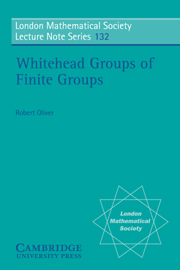Book contents
- Frontmatter
- Contents
- Introduction
- Part I General theory
- Chapter 1 Basic algebraic background
- Chapter 2 Structure theorems for K1 of orders
- Chapter 3 Continuous K2 and localization sequences
- Chapter 4 The congruence subgroup problem
- Chapter 5 First applications of the congruence subgroup problem
- Chapter 6 The integral p–adic logarithm
- Part II Group rings of p–groups
- Part III General finite groups
- References
- Index
Chapter 5 - First applications of the congruence subgroup problem
Published online by Cambridge University Press: 17 December 2009
- Frontmatter
- Contents
- Introduction
- Part I General theory
- Chapter 1 Basic algebraic background
- Chapter 2 Structure theorems for K1 of orders
- Chapter 3 Continuous K2 and localization sequences
- Chapter 4 The congruence subgroup problem
- Chapter 5 First applications of the congruence subgroup problem
- Chapter 6 The integral p–adic logarithm
- Part II Group rings of p–groups
- Part III General finite groups
- References
- Index
Summary
The results in this chapter are a rather miscellaneous mixture. Their main common feature is that they all are simple applications of the congruence subgroup problem (Theorem 4.13) to study Cl1 of group rings; applications which do not require any of the tools of the later chapters.
In Section 5a, the group G = C4 × C2 × C2 is used to illustrate the computation of SK1(ℤ[G]) (≅ ℤ/2); as well as the procedures for constructing and detecting explicit matrices representing elements of SK1(ℤ[G]). Several vanishing results are then proven in Section 5b: for example, that Cl1(R[G]) = 1 whenever G is cyclic and R is the ring of integers in an algebraic number field (Theorem 5.6), that Cl1(ℤ[G]) = 1 if G is any dihedral, quaternion, or symmetric group (Example 5.8 and Theorem 5.4), and that Cl1(R[G]) is generated by induction from elementary subgroups of G (Theorem 5.3). These are all based on certain natural epimorphisms ℐRG: Rℚ(G) ↠ Cl1(R[G]); epimorphisms which are constructed in Proposition 5.2. In Section 5c, the “standard involution” on Whitehead groups is defined; and is shown, for example, to be the identity on C(ℚ[G]) and Cl1 (ℤ[G]) for any finite group G.
Constructing and detecting elements in SK1 (ℤ[G]): an example
We first focus attention on one particular group abelian G; and sketch the procedures for computing SK1(ℤCG]) (= Cl1(ℤCG])), for constructing an explicit matrix to represent its nontrivial element, and for detecting whether a given matrix does or does not vanish in SK1(ℤ[G]).
- Type
- Chapter
- Information
- Whitehead Groups of Finite Groups , pp. 127 - 152Publisher: Cambridge University PressPrint publication year: 1988

